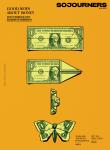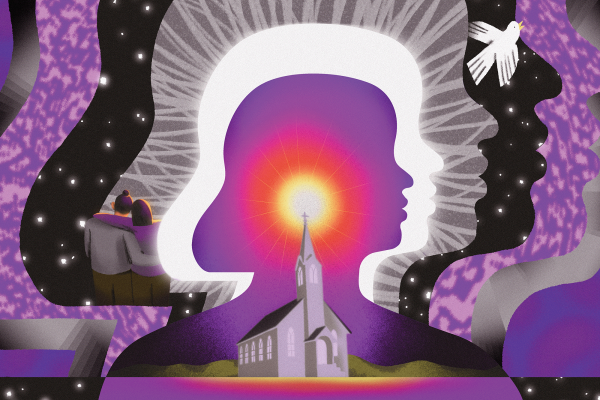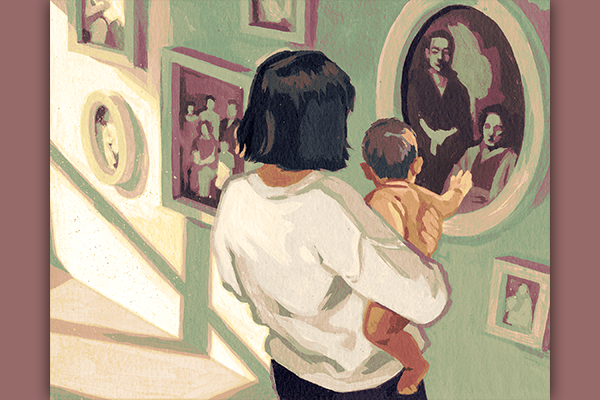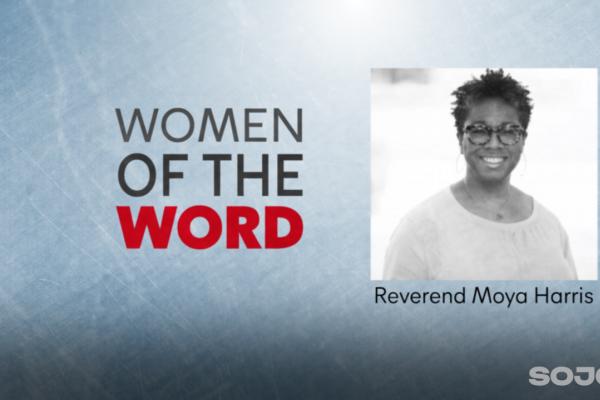GROWING UP, I didn’t understand why boys obsessed over girls. “Oh, you will when you’re older,” my dad kept telling me into my early 20s. Only then did I confront what I should’ve known long ago: I’m gay — but not just gay. I am romantically, but not sexually, attracted to men. My father promised that (hetero)sexual desire came with manhood, so am I less of a man?
Many conservative Christian marital counselors and sex manualists have implied that the answer is “yes.” John Eldredge, author of Wild at Heart, wrote that men “come alive” when they have a “a beauty to rescue.” In The Act of Marriage, Tim and Beverly LaHaye wrote that men’s “need for romantic love is either nonexistent or minimal.” Willard F. Harley Jr., in His Needs, Her Needs, wrote that sex is the “first thing [men] can’t do without.” Stephen Arterburn and Fred Stoeker, in Every Man’s Battle, wrote that “maleness” is heterosexual desire. Their message is clear: Sex is essential to God’s vision for manhood.
But every person can live a full, godly life without sex and romance, whether one has desires for both, either, or neither. For many asexual believers, both secular and so-called Christian understandings of sexuality have been insufficient and harmful to them — and to everyone. Perhaps understanding asexuality can lead Christians toward a more inclusive, beautiful, and faithful set of sexual ethics.
What’s ‘ace’?
ASEXUALITY (OR “ACE” for short) is asexual orientation in which a person experiences little to no sexual attraction. Since the early 2000s, it has been increasingly accepted under the LGBTQ+ umbrella through the influence of online forums, social media, and the Asexual Visibility and Education Network. Like many queer orientations, it’s been mislabeled and misunderstood for centuries.
Frigiditas (“coldness”) was used in the 13th century by Pope Gregory IX to describe people who experienced little to no sexual pleasure due to physiological conditions such as impotence and infertility. This gradually became known as “frigidity” — a condition assigned to women as a mental illness. By the late 19th century, frigidity was not just a problem to treat but a perversion to absolve with coercive “solutions” such as marital rape.
In 1896, German sexologist Magnus Hirschfeld, who conducted groundbreaking LGBTQ+ research, observed people without a sex drive, eventually calling them anerotic or asexual. In 1948, American sexologist Alfred Kinsey created a scale of attraction for men from heterosexual to homosexual, reporting that 1.5 percent of men had “no socio-sexual contacts or reactions”; they were excluded from his scale and deemed group “X.” In the 20th century, feminist scholars including Myra T. Johnson and Lisa Orlando engaged asexuality as the freedom from patriarchy to not have sex. In 2004, psychologist Anthony F. Bogaert found that 1 percent of a British population sample reported they “never felt sexually attracted to anyone at all.”
Until 2013, the American Psychiatric Association’s Diagnostic and Statistical Manual of Mental Disorders generally categorized “low or decreased sexual desire” that caused “marked distress or interpersonal difficulties” as a disorder. Since then, the DSM acknowledges that “if a lifelong lack of sexual desire” can be “explained by one’s self-identification as ‘asexual,’” then it is not diagnosed as a medical condition. Julie Sondra Decker, author of The Invisible Orientation: An Introduction to Asexuality, wrote, “Yes, it is possible to have a hormone deficiency, or an illness, or to be on a medication that contributes to lack of interest in or enjoyment of sex.” But these conditions are commonly absent from asexuals, so a “lack of sexual interest can be a symptom of a broader condition, but it is not an illness in and of itself,” Decker wrote. Nevertheless, asexuality is still presumed to be a disorder by some in the medical field.
Psychology professor Gordon Hodson, studying university and community populations in 2012 to measure heterosexual prejudice toward sexual minorities, found that asexuals were perceived as the most “animal-like” and “machine-like” and the least desirable sexual minority to interact with, rent to, or hire. The United Kingdom’s Government Equalities Office found that asexuals have slightly higher incidences of suicidality, poor mental health, and negative reactions from peers and medical practitioners than other sexual minorities.
In my case, traditional Christian teachings on male sexuality made me feel broken for years. I internalized my preferences as deficiencies, denying my romantic feelings because I thought I’d be a hindrance and disappointment to potential partners. But every healthy relationship contains differences and compromise. While uncommon, my longing to live for and with a partner — without a need for sex — is one path toward relational fulfillment, just as marriage with sex is for others, or family, friendship, or community is enough for some. I’m reminded of LGBTQ+ advocate Justin Lee’s appeal to a largely straight Christian audience that gets to the heart of all relationships: “The conversation ends up being about sexual morality, and what God wants for us sexually. Now, sex is a part of marriage, but the big question ... [is] about companionship, and love, and who cares for us when we get sick.”
Asexuality is about attraction, not behavior; it’s an orientation, not a choice like celibacy or abstinence; it’s about sex favorability, not sex negativity. There is a nuanced spectrum of asexual attraction types and levels of intimacy, but painstaking detail “gives everything a gloss of scientific legitimacy that almost no explanation can fully claim,” wrote Angela Chen, author of Ace: What Asexuality Reveals About Desire, Society, and the Meaning of Sex. Complexity doesn’t delegitimize how asexual people experience love and desire, however. The key point, Chen wrote, is that “wanting sex should not be a requirement of health or humanity.”
The double bind of purity culture
“PURITY CULTURE” GREW out of the American evangelical push to return to “traditional” Christian sexual ethics through shame-based teaching. It taught that strict abstinence while single led to sexual flourishing once wed, while premarital sex wrought eternal destruction to body and soul. Its assumptions about the power of sex for good and ill have some roots with Protestant reformers such as Martin Luther, who wrote that sex is “not a matter of free choice or decision but a natural and necessary thing.” Sociologist Bridget Eileen Rivera wrote, “The reformers introduced new assumptions to the Christian imagination — sex and sexuality as integral to human identity; celibacy as unnatural; marriage as a human right; pursuit of marriage for romantic love.” These sexual ideals have shaped church doctrine and Western culture.
From the 1990s to the early 2010s, evangelical purity movement advocates secured federal funding for abstinence education that produced widespread events (such as the Silver Ring Thing), popularized books (such as I Kissed Dating Goodbye), and drafted celebrities (including Miley Cyrus). Along the way, complementarianism and New Calvinism helped theologically form and nationally propagate purity culture.
Under purity culture, men are seen as hypersexual, sex-entitled animals and violent, yet chivalrous, warriors. Women are to be their servile gatekeepers and objectified sex outlets, expected to exist as sexless beings in their behavior and attire. When women fail to meet this impossible standard, they might be blamed as temptresses or labeled as “damaged goods.” Nadia Bolz-Weber wrote in Shameless: A Sexual Reformation that “when the boundaries, protections, and rules become more important than the sacred thing they are intended to protect, casualties ensue.”
A movement that promotes abstinence might seem compatible with asexuality, but the reality is more complicated. “Purity culture demands that you struggle with [no sex], and that you want it, and that you are eventually going to get married,” writer Jenna DeWitt told Sojourners. Reflecting on past experiences of purity culture, some asexuals told Sojourners they felt comfort, pride, or confusion in contrast to peers struggling with lust. I felt these emotions throughout much of my life but had no language or examples to make sense of my otherness. I was flailing, unable to adopt heteronormative standards that deeply repressed my real feelings and sexuality. This is the double bind of asexuals in purity culture: We are sexually righteous one moment, sexually broken the next.
“Purity culture both represses and compels sex, in the long run,” sociologist Canton Winer told Sojourners. This distortion can create a gendered erasure for men “because asexuality is seen as impossible” for them and for women “because it’s seen as unremarkable.”
Compulsory sexuality
SECULAR CULTURE, WHICH manifests its own kind of obsession with sex and gender stereotypes through media and societal norms, did not provide role models for me or viable alternatives to purity culture.
Western society inherited “gender essentialism” (i.e., traditional gender roles and expression) from the Greco-Roman era. Rivera wrote that this created “a ‘symbolic link’ between sex and gender wherein one determines the other.” This is when differences between men and women are culturally projected, even enforced, by appeals to science and the divine — different shades of “biological determinism.”
In 1980, poet and essayist Adrienne Rich called this “compulsory heterosexuality,” where being straight isn’t just a sexual orientation but an enshrined “political institution.” Asexual discourse borrows this idea and expands it to compulsory sexuality. This isn’t about forced sex but rather the cultural pressure and expectation that all people, regardless of their orientation, will want and have sex.
“Those who deprioritize or divest from sex ... regardless of the reasons why, become a threat to the established systems that rely and thrive on the exploitation of and extraction of labor from our bodies, including sexual and reproductive labor,” wrote Sherronda J. Brown, author of Refusing Compulsory Sexuality. Because sex is tied to value and productivity, it “continues to be regarded as a rite of passage and a marker of maturity.” Anyone who can’t get or rejects sex often draws suspicion or scrutiny.
Brown argues that compulsory sexuality not only perpetuates racist and sexist stereotypes, but also brings LGBTQ+ people into the conservative trap that queerness is only about sex, since “many queer people ... conceive of sex acts as the catalysts for queerness itself.” This, Brown asserts, “leaves a lot of queer people, especially young ones, feeling pressured to have a certain amount or a certain type of sex in order to legitimate or prove their queerness to themselves or someone else.” Experiencing sexual attraction, along with associated standards of sexual drive and desires, is assumed to be the default for both straight and LGBTQ+ people.
This connects back to many churches, where the cultures, programs, and theologies promote compulsory coupling. Single people — straight and queer — can feel left behind, and putting marriages on a pedestal isn’t healthy for couples either. DeWitt says it can pressure couples “to have their entire worth and identity around maintaining this façade that they can do it all alone and don’t need anyone else.” She adds that this deprioritizes church community, friendships, and extended family, and marriages suffer for it.
Christian (a)sexual ethics
I ONCE SAW my asexuality as broken, but now view it as a blessing that helps me to see injustices across traditional Christian and secular norms of sexuality. Faith and asexuality point toward a better vision for relationships that are marked by mutuality. Bolz-Weber wrote, “Concern moves us closer to the heart of Jesus’ own ethic: love God and our neighbor as ourselves. It requires us to act on another’s behalf. ... The only way to show true concern for ourselves and others is to see, to pay attention.” Bridget Eileen Rivera wrote that eroticism and intimacy are relational experiences at their cores, formed by “emotional, romantic, aesthetic, physical, and intellectual components, among others,” whereas compulsory sexuality would limit these to sexual activity alone.
Compulsory sexuality also “eschews consent and preaches instant gratification for people who want sex,” Brown wrote, “but cares not for the safety, comfort, health, or autonomy of people who do not.” Real consent — as one asexual woman told Sojourners — is meant “to break the distinction between my well-being and your well-being.” Her partner added, “To respect someone is to follow their word. To love someone is to understand. To be with their boundary, rather than just to do what they say.” Mutuality, then, is care and concern toward another with an expansive attention to attraction and consent, bringing partners of all orientations into even deeper knowledge of each other’s needs and desires. The apostle Paul tells us that freedom isn’t about our pleasure, but how we can serve others in love (Galatians 5:13).
For me and for others, asexuality helps recenter truly traditional Jesus values in our sexuality and expands the kinds of relationships that can be fostered in faith communities. Asexuals commonly used “liberation,” “freedom,” and “openness” to describe their orientation to Sojourners. “True freedom is interconnected. It’s collective,” DeWitt said. And social justice “goes beyond tolerance and openness into fighting for each other’s flourishing” — where everyone thrives in the messy yet freeing work of leaving purity culture and compulsory sexuality behind. In God’s kingdom, asexual liberation leads to liberation for all.

Got something to say about what you're reading? We value your feedback!






